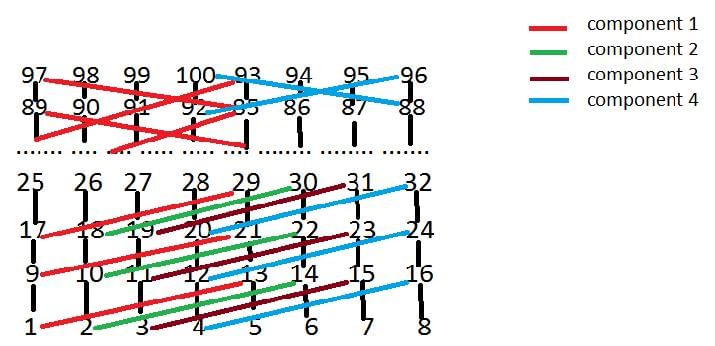Computer Science Engineering (CSE) Exam > Computer Science Engineering (CSE) Questions > Let G be the graph with 100 vertices numbered...
Start Learning for Free
Let G be the graph with 100 vertices numbered 1 to 100. Two vertices i and j are adjacent iff |i−j|=8 or |i−j|=12. The number of connected components in G is
- a)8
- b)4
- c)12
- d)25
Correct answer is option 'B'. Can you explain this answer?
Most Upvoted Answer
Let G be the graph with 100 vertices numbered 1 to 100. Two vertices i...
When vertices are arranged with difference of 8 there are 8 components as shown by 8 columns in the image below:

When vertices are arranged withdifference of 12 the number of components is reduced to 4 as first column will be connected with fifth column, second column will be connected with sixth column, third column will be connected with seventh column and fourth column will be connected with eighth column. No other form of connection exists so total 4 connected components are there. So, option (B) is correct. This explanation is contributed by Pradeep Pandey.
Free Test
FREE
| Start Free Test |
Community Answer
Let G be the graph with 100 vertices numbered 1 to 100. Two vertices i...
The graph G has 100 vertices numbered from 1 to 100. Two vertices i and j are adjacent if and only if |i-j| ≤ 5.
To find the number of edges in this graph, we need to count the number of pairs of adjacent vertices.
For any vertex i, there are 10 vertices (i-5, i-4, ..., i-1, i+1, ..., i+5) that are adjacent to it. However, we need to consider the cases where i ≤ 5 or i ≥ 96 separately, since there will be fewer adjacent vertices for these vertices.
For i ≤ 5, there are only 5 adjacent vertices (i+1, i+2, i+3, i+4, i+5).
For i ≥ 96, there are only 5 adjacent vertices (i-1, i-2, i-3, i-4, i-5).
For the remaining vertices 6 ≤ i ≤ 95, there are 10 adjacent vertices.
So, the total number of edges in the graph G is:
(5 vertices with 5 adjacent vertices) + (90 vertices with 10 adjacent vertices) + (5 vertices with 5 adjacent vertices) = 5*5 + 90*10 + 5*5 = 25 + 900 + 25 = 950.
Therefore, the graph G has 950 edges.
To find the number of edges in this graph, we need to count the number of pairs of adjacent vertices.
For any vertex i, there are 10 vertices (i-5, i-4, ..., i-1, i+1, ..., i+5) that are adjacent to it. However, we need to consider the cases where i ≤ 5 or i ≥ 96 separately, since there will be fewer adjacent vertices for these vertices.
For i ≤ 5, there are only 5 adjacent vertices (i+1, i+2, i+3, i+4, i+5).
For i ≥ 96, there are only 5 adjacent vertices (i-1, i-2, i-3, i-4, i-5).
For the remaining vertices 6 ≤ i ≤ 95, there are 10 adjacent vertices.
So, the total number of edges in the graph G is:
(5 vertices with 5 adjacent vertices) + (90 vertices with 10 adjacent vertices) + (5 vertices with 5 adjacent vertices) = 5*5 + 90*10 + 5*5 = 25 + 900 + 25 = 950.
Therefore, the graph G has 950 edges.

|
Explore Courses for Computer Science Engineering (CSE) exam
|

|
Question Description
Let G be the graph with 100 vertices numbered 1 to 100. Two vertices i and j are adjacent iff |i−j|=8 or |i−j|=12. The number of connected components in G isa)8b)4c)12d)25Correct answer is option 'B'. Can you explain this answer? for Computer Science Engineering (CSE) 2025 is part of Computer Science Engineering (CSE) preparation. The Question and answers have been prepared according to the Computer Science Engineering (CSE) exam syllabus. Information about Let G be the graph with 100 vertices numbered 1 to 100. Two vertices i and j are adjacent iff |i−j|=8 or |i−j|=12. The number of connected components in G isa)8b)4c)12d)25Correct answer is option 'B'. Can you explain this answer? covers all topics & solutions for Computer Science Engineering (CSE) 2025 Exam. Find important definitions, questions, meanings, examples, exercises and tests below for Let G be the graph with 100 vertices numbered 1 to 100. Two vertices i and j are adjacent iff |i−j|=8 or |i−j|=12. The number of connected components in G isa)8b)4c)12d)25Correct answer is option 'B'. Can you explain this answer?.
Let G be the graph with 100 vertices numbered 1 to 100. Two vertices i and j are adjacent iff |i−j|=8 or |i−j|=12. The number of connected components in G isa)8b)4c)12d)25Correct answer is option 'B'. Can you explain this answer? for Computer Science Engineering (CSE) 2025 is part of Computer Science Engineering (CSE) preparation. The Question and answers have been prepared according to the Computer Science Engineering (CSE) exam syllabus. Information about Let G be the graph with 100 vertices numbered 1 to 100. Two vertices i and j are adjacent iff |i−j|=8 or |i−j|=12. The number of connected components in G isa)8b)4c)12d)25Correct answer is option 'B'. Can you explain this answer? covers all topics & solutions for Computer Science Engineering (CSE) 2025 Exam. Find important definitions, questions, meanings, examples, exercises and tests below for Let G be the graph with 100 vertices numbered 1 to 100. Two vertices i and j are adjacent iff |i−j|=8 or |i−j|=12. The number of connected components in G isa)8b)4c)12d)25Correct answer is option 'B'. Can you explain this answer?.
Solutions for Let G be the graph with 100 vertices numbered 1 to 100. Two vertices i and j are adjacent iff |i−j|=8 or |i−j|=12. The number of connected components in G isa)8b)4c)12d)25Correct answer is option 'B'. Can you explain this answer? in English & in Hindi are available as part of our courses for Computer Science Engineering (CSE).
Download more important topics, notes, lectures and mock test series for Computer Science Engineering (CSE) Exam by signing up for free.
Here you can find the meaning of Let G be the graph with 100 vertices numbered 1 to 100. Two vertices i and j are adjacent iff |i−j|=8 or |i−j|=12. The number of connected components in G isa)8b)4c)12d)25Correct answer is option 'B'. Can you explain this answer? defined & explained in the simplest way possible. Besides giving the explanation of
Let G be the graph with 100 vertices numbered 1 to 100. Two vertices i and j are adjacent iff |i−j|=8 or |i−j|=12. The number of connected components in G isa)8b)4c)12d)25Correct answer is option 'B'. Can you explain this answer?, a detailed solution for Let G be the graph with 100 vertices numbered 1 to 100. Two vertices i and j are adjacent iff |i−j|=8 or |i−j|=12. The number of connected components in G isa)8b)4c)12d)25Correct answer is option 'B'. Can you explain this answer? has been provided alongside types of Let G be the graph with 100 vertices numbered 1 to 100. Two vertices i and j are adjacent iff |i−j|=8 or |i−j|=12. The number of connected components in G isa)8b)4c)12d)25Correct answer is option 'B'. Can you explain this answer? theory, EduRev gives you an
ample number of questions to practice Let G be the graph with 100 vertices numbered 1 to 100. Two vertices i and j are adjacent iff |i−j|=8 or |i−j|=12. The number of connected components in G isa)8b)4c)12d)25Correct answer is option 'B'. Can you explain this answer? tests, examples and also practice Computer Science Engineering (CSE) tests.

|
Explore Courses for Computer Science Engineering (CSE) exam
|

|
Signup for Free!
Signup to see your scores go up within 7 days! Learn & Practice with 1000+ FREE Notes, Videos & Tests.























